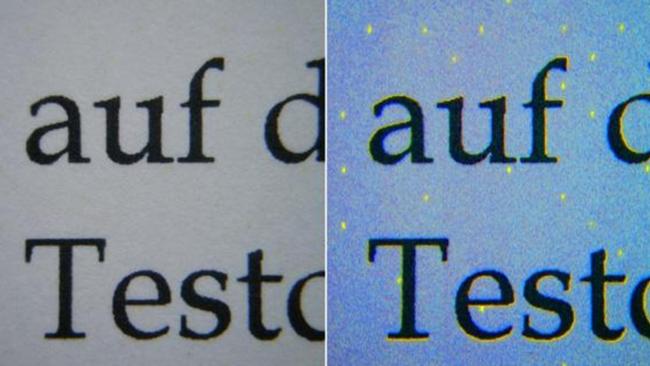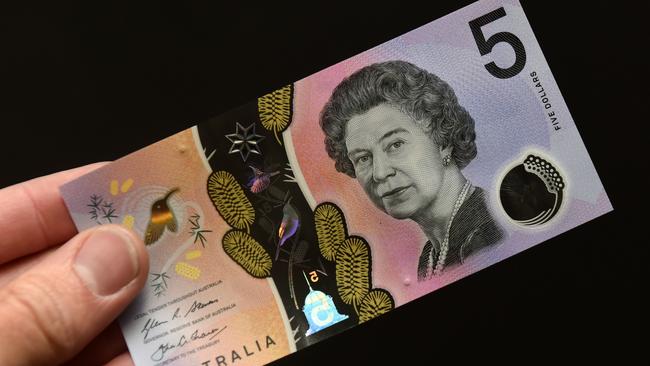From five dollar notes to word documents, here are the secret codes hidden in plain sight
DID you know your five dollar note has a hidden code that prevents certain tasks? This is only one example of clandestine messages tucked away in plain sight.

NEXT time you go to do something nefarious with a printer from work, you might want to think again because your actions might be much more traceable than you think.
Even if you somehow manage to escape leaving the obvious digital footprint that comes from using a printer connected to your work computer, there is a way your actions could be tracked.
What if I told you that laser printers place yellow dots, less than a millimetre in diameter, in a coded pattern on your document.
This pattern, hidden in plain sight, contains the printer’s serial number, and the date and time the documents were printed, making you more accountable than you would like to believe.
So why can’t you see the yellow dots?
Despite covering less than one-thousandth of the page, the yellow dots are invisible to the naked eye when placed over a white background unless placed under a blue LED light.
The revelation was first revealed around 2004 when senior research fellow at Xerox Peter Crean told about tiny yellow dots tucked around the words and margins on every document.
Xerox was not the only company to use microdots, with the Electronic Frontier Foundation holding a list of colour printers implementing the technology.
Now retired, Mr Crean said other than his article in PC World 13 years ago, printing companies remain fairly tight-lipped about the technology.
“We didn’t advertise it much to the people that had [the printers],” he told Quartz.
“We didn’t not tell them if they asked. The salespeople were told, ‘Don’t lead with it in any sales, but if they ask you about it, you can tell them we have the security feature in there’.”
While technology has clearly advanced since the early age of laser printers, microdots are still very much present — something discovered in a top secret NSA document published by The Intercept earlier this month.

Unbeknown to the publication at the time, the published document contained a hidden code that identified NSA contractor Reality Winner as the source of the leak.
Security expert Rob Graham explained by downloading the document and inverting the colours in a photo editing program, he was able to reveal a pattern.
When plotted against a grid, these yellow dots denoted specific hours, minutes, dates and numbers.
Thus by reverse-engineering the grid pattern, researchers were able to discover the document had come from a printer with the serial number 535218 or 29535218 — more than enough information to reveal the source.
Funnily enough investigators didn’t need to get so crafty, with an affidavit released by the Department of Justice explaining Winner had actually sent the document to the media outlet from her work email and this is how she was captured.
“The US Government Agency determined that six individuals printed this reporting. Winner was one of these six individuals,” the affidavit read.
“A further audit of the six individuals’ desk computers revealed that Winner had email contact with the News Outlet. The audit did not reveal that any of the other individuals had email contact with the News Outlet.”
While helpful in instances such as this, the yellow dots are also instrumental in helping to expose fraudsters trying to pass a forged document printed in the past six months as something from 2005.
OTHER SECRET MESSAGES

Printed yellow dots are not the only type of steganography — secret codes hidden in plain sight — with a number of examples having long existed in everyday life.
To prevent counterfeiting of money, many bank notes around the world contain a five-point pattern known as the Eurion constellation.
When photocopies or scanners come across this pattern, they are programmed to not make copies.
Microdot technology is even available commercially, with companies like Alpha Dot selling vials of permanent adhesive full of pinhead sized dots.
These dots contain a unique serial number in microscopic text, which the police can examine when recovering a stolen item.
Some steganography doesn’t even use markings at all, with the whitespaces and tabs at the end of lines on documents sometimes being the code.
Security expert Alan Woodward likened locating trailing whitespace in text to finding a polar bear in a snowstorm.
“The encoding scheme used by snow relies on the fact that spaces and tabs (known as whitespace), when appearing at the end of lines, are invisible when displayed in pretty well all text viewing programs,” he wrote.
“This allows messages to be hidden in ASCII text without affecting the text’s visual representation. And since trailing spaces and tabs occasionally occur naturally, their existence should not be sufficient to immediately alert an observer who stumbles across them.”
Did you know of these secret codes? Continue the conversation in the comments below or with Matthew Dunn on Facebook and Twitter.



